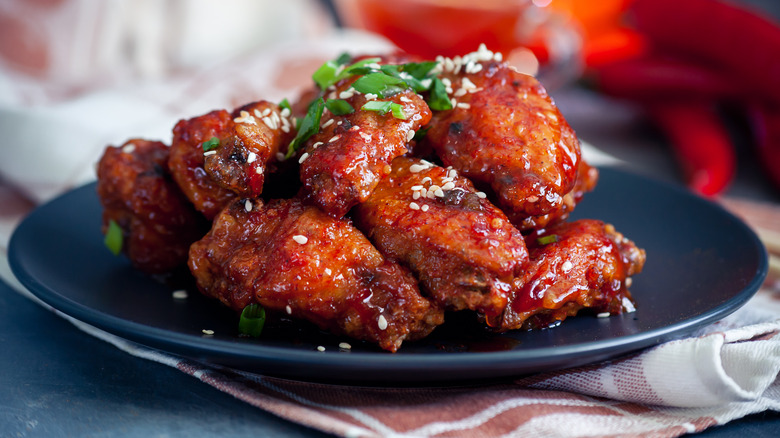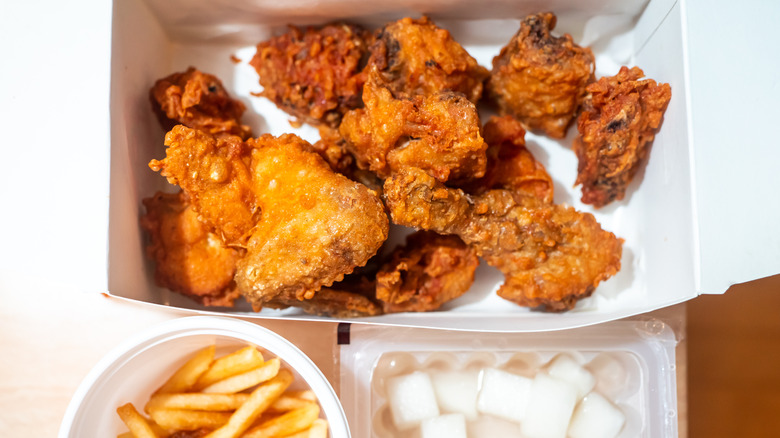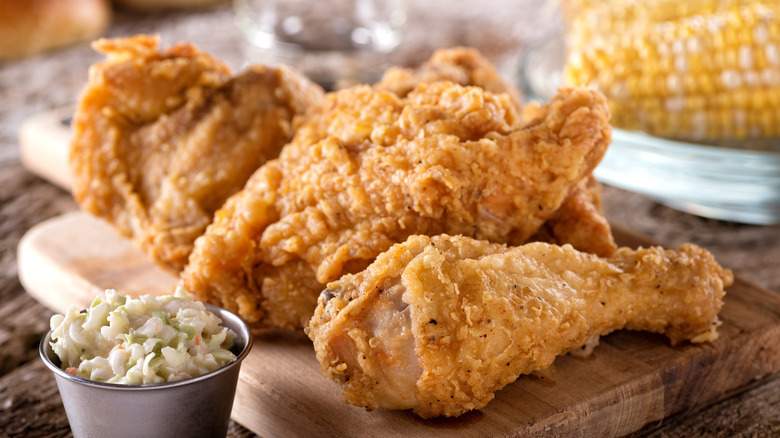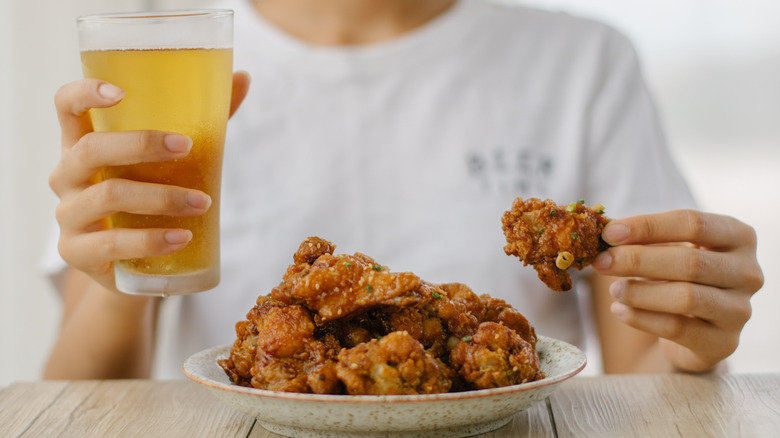Korean Fried Chicken Was Invented On The Battlefield
All good food tells a story, and Korean fried chicken is no different. Dishes can change as people adjust to the available ingredients, fine-tune to cultural preferences, and deal with hardships. What seems like a humble chicken dish at first can reveal quite a storied past.
In the 1940s and 1950s, South Korea, supported by the United States, was embroiled in a brutal proxy war with North Korea, which the former Soviet Union and China supported. The story goes that during Thanksgiving one year, American soldiers stationed in South Korea wanted to prepare a meal that reminded them of home, but they had no access to turkey. Instead, they used chicken and decided to fry it and then shared the meal with their fellow Korean soldiers. Most commonly, chicken was eaten steamed or boiled in Korea, like in Samgyetang where a small, whole, rice-stuffed chicken is cooked in a ginseng broth, so the crispy delicacy caught on quickly.
What is Korean fried chicken?
Korean fried chicken is known for being extra crunchy and is often dunked in a punchy sauce. Bone-in chicken pieces or chicken wings are popular. The chicken is dipped in a thin cornstarch batter and double-fried, resulting in a shatteringly crispy exterior. They can be served plain, called huraideu for maximum crunch, but yangnyeom tongdak is probably the most popular preparation. The chicken is covered in a bright red sweet and spicy sauce that combines Korean fermented red pepper paste called gochujang, garlic, rice syrup, and ketchup.
Dakgangjeong has a soy sauce-based sauce, padak gets a pile of thinly sliced green onions and a sweet soy and mustard sauce, and honey butter sauce remains a sweet classic. Korean fried chicken was and still is a hugely popular delivery item in densely populated Korean cities, and everyone has their favorite neighborhood joint to grab takeout from. It is typically served with cubes of tangy pickled daikon radish called chicken-mu.
A cold beer is another perfect accompaniment. Korean drinking culture runs deep and is considered to be an integral part of forming social bonds, celebrating achievements, and fostering good work relationships. Food goes hand in hand with drinking, especially something salty and rich like Korean fried chicken. In fact, there is a specific word in Korean that names this quintessential pairing, combining the words for chicken and beer — chimaek.
Korean fried chicken – how it started
Fried chicken has existed worldwide for thousands of years, with roots in China, the Middle East, and West Africa, but Korean fried chicken evolved from the fried chicken popularized by the southern United States. Though the exact history is not known for certain, southern-style fried chicken was definitely created and perfected by enslaved Africans and their descendants. Frying chicken was a part of West African cooking, but it was usually braised after being lightly fried. It is likely that enslaved people started cooking fried chicken with their own distinctive seasonings and style based on pan-fried chicken recipes given to them by Scottish slave owners sometime around the 17th century.
Fried chicken used to be reserved for special occasions like after Sunday church services and Fourth of July celebrations because of how labor-intensive it was to prepare fresh chicken, but by the late 1800s, Black women entrepreneurs saw an opportunity to sell fried chicken to train travelers. They were very successful, and in fact, the chicken popularized by one Colonel Harland Sanders was lifted from techniques perfected by these women. Fried chicken is deeply ingrained in Black American culture, which could be why the introduction of fried chicken to South Korea is sometimes attributed specifically to Black soldiers from the United States.
Korean fried chicken – how it's going
Fried chicken in South Korea was initially also considered a special occasion meal during the 1960s. After the Korean War, people couldn't afford the luxury. In popular culture, fathers making a stable salary would bring fried chicken or American-style rotisserie chickens home on payday, an aspirational image out of reach for most of the country.
Economic liberalization in the 1970s and 1980s sparked massive growth in the country. Korean people had more disposable income, and food became more affordable. Many fried chicken restaurants began opening, accessible to the masses. Kentucky Fried Chicken opened up shop in South Korea in 1984 and positioned itself as the ideal for dine-out fried chicken.
Of course, after an economic boom comes a bust. When the Asian financial crisis hit in 1997, many of the primarily male workforce in Korea lost their stable, corporate, pension-destined jobs. Many were forced into an early and unstable retirement with a lump sum payout. In search of another way to support their families, many turned to open take-out and delivery fried chicken shops. This is where the Korean fried chicken that is well-known today truly became mainstream. Since then, this decidedly Korean take on southern fried chicken has made its way back to the United States. Whether at a noteworthy restaurant like KoChix, a Bonchon franchise, or in an H Mart food court, this tasty fried chicken is available stateside and here to stay.




